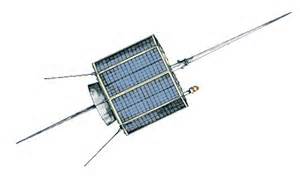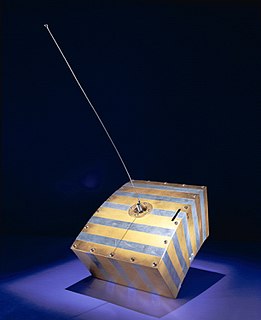AMSAT is a name for amateur radio satellite organizations worldwide, but in particular the Radio Amateur Satellite Corporation (AMSAT) with headquarters at Washington, D.C. AMSAT organizations design, build, arrange launches for, and then operate (command) satellites carrying amateur radio payloads, including the OSCAR series of satellites. Other informally affiliated national organizations exist, such as AMSAT Germany (AMSAT-DL) and AMSAT Japan (JAMSAT).
AMSAT-OSCAR-40, also known as AO-40 or simply OSCAR 40, was the on-orbit designation of an amateur radio satellite of the OSCAR series. Prior to launch, the spacecraft was known as Phase 3D or "P3D". AO-40 was built by AMSAT.

AMSAT-OSCAR 51 or AO-51 is the in-orbit name designation of a now defunct LEO amateur radio satellite of the OSCAR series; formerly known as ECHO, built by AMSAT. It was launched on June 29, 2004 from Baikonur Cosmodrome, Kazakhstan on a Dnepr launch vehicle. It is in sun synchronous low Earth orbit.
HAMSAT also known as HAMSAT INDIA, VU2SAT and VO-52 is a microsatellite weighing 42.5 kilograms (93.7 lb), providing amateur radio satellite communications services for Indian and international amateur radio operators. This satellite carries the in-orbit designation of VO-52, and is an OSCAR series satellite.
The Stellenbosch UNiversity SATellite is the first miniaturized satellite designed and manufactured in South Africa. It was launched aboard a Delta II rocket from the Vandenberg Air Force Base on 23 February 1999. Sunsat was built by post-graduate engineering students at the University of Stellenbosch. Its AMSAT designation was SO-35.

AMSAT-OSCAR 7, or AO-7, is the second Phase 2 amateur radio satellite constructed by the Radio Amateur Satellite Corporation or AMSAT. It was launched into Low Earth Orbit on November 15, 1974 and remained operational until a battery failure in 1981. Then after 21 years of apparent silence, the satellite was heard again on June 21, 2002 – 27 years after launch. At that time the public learned that the satellite had remained intermittently functional and was used surreptitiously for communication by the anticommunist opposition Fighting Solidarity during the martial law in Poland.
AMSAT-OSCAR 16, also known as AO-16 and PACSAT, is the in-orbit name designation of an amateur radio satellite of the OSCAR series. It was built by AMSAT and was launched on 22 January 1990 from Kourou, French Guiana on an Ariane 4 launch vehicle. It is in sun synchronous low Earth orbit.
An amateur radio satellite is an artificial satellite built and used by amateur radio operators. It forms part of the Amateur-satellite service. These satellites use amateur radio frequency allocations to facilitate communication between amateur radio stations.
AMSAT-OSCAR 6 was the first Phase 2 amateur radio satellite (P2-A) launched into low Earth orbit. It was also the first satellite constructed by the new AMSAT North America (AMSAT-NA) organization.

OSCAR II is the second amateur radio satellite launched by Project OSCAR into Low Earth orbit. OSCAR II was launched June 2, 1962, by a Thor-DM21 Agena B launcher from Vandenberg Air Force Base, Lompoc, California. The satellite, a rectangular box weighing 10 kg (22 lb), was launched as a secondary payload (ballast) for Corona 43, the fifth launch of a KH-4 satellite.

OSCAR IV was the fourth amateur radio satellite launched by Project OSCAR and the first targeted for Geostationary orbit on 12 December 1965. The satellite was launched piggyback with three United States Air Force satellites on a Titan IIIC launch vehicle. Due to a booster failure, OSCAR 4 was placed in an unplanned and largely unusable Geostationary transfer orbit; however, OSCAR 4 did facilitate the first direct satellite communication between the United States and the USSR.

FUNcube-1 is a complete educational single unit CubeSat satellite with the goal of enthusing and educating young people about radio, space, physics and electronics. It is part of a program which aims to launch more of these educational CubeSats. It is the first satellite with outreach as its primary mission.

OSCAR I is the first amateur radio satellite launched by Project OSCAR into low Earth orbit. OSCAR I was launched December 12, 1961, by a Thor-DM21 Agena B launcher from Vandenberg Air Force Base, Lompoc, California. The satellite, a rectangular box weighing 10 kg., was launched as a secondary payload (ballast) for Corona 9029, also known as Discoverer 36, the eighth and final launch of a KH-3 satellite.

Dove-OSCAR 17 is a Brazilian educational and amateur radio satellite (BRAMSAT) (AMSAT-BRAZIL) launched on 22 January 1990.
Fox-1D, AO-92 or AMSAT OSCAR 92 is an American amateur radio satellite. Fox-1D is a 1U CubeSat developed and built by AMSAT-NA. Fox-1D carries a single-channel transponder for mode U/V in FM. Fox-1D has an L-band converter, which allows the FM transponder to be switched on an uplink in the 23 centimetres (9.1 in) band.
Fox-1B, AO-91 or AMSAT OSCAR 91 is an United States amateur radio satellite. It is a 1U Cubesat, was built by the AMSAT-NA and carries a single-channel transponder for FM radio. The satellite has a whip antenna for the 70 cm and 23 cm bands (uplink), and a second antenna for the 2 m band (downlink). Fox-1B is the second amateur radio satellite of the Fox series of AMSAT North America.
Fox-1A, AO-85 or AMSAT OSCAR 85 is an American amateur radio satellite. It is a 1U Cubesat, was built by the AMSAT-NA and carries a single-channel transponder for FM radio. The satellite has one rod antenna each for the 70 centimetres (28 in) and 2 metres bands. To enable a satellite launch under NASA's Educational Launch of Nanosatellites (ELaNa) program, the satellite continues to carry a Penn State University student experiment.
Fox-1Cliff, AO-95 or AMSAT OSCAR 95 is an American amateur radio satellite. Fox-1Cliff is a 1U CubeSat built by AMSAT-NA that carries a single-channel transponder for mode U/V in FM.
Weber-OSCAR 18 is an American amateur radio satellite.
Eyesat-1 is an American experimental communications microsatellite with an store-dump payload. The mission of Eyesat-1 was experimental monitoring of mobile industrial equipment. Eyesat-1 has provided the National Oceanic and Atmospheric Administration in Silver Spring, Maryland, with communication services to the South Pole. Eyesat-1 carries an FM repeater for Amateur Radio Research and Development Corporation (AMRAD) called AMRAD OSCAR 27 or OSCAR 27.








